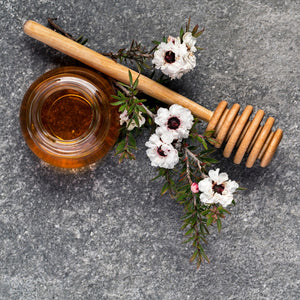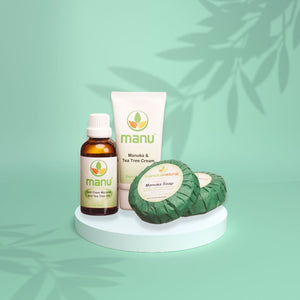
Manuka honey from New Zealand may replace conventional medication
Why ignoring Manuka Honey from New Zealand may cost you time and relief?
You may have heard about the benefits of manuka honey from New Zealand on many forums?! But somehow it is hard to believe that a sweet and flavorful treat can have such potential to relieve you from several health problems.
All at once!
But, you know what? Not all honey is created equal. The composition of each
honey differs. That is especially true for manuka honey from New Zealand.
It’s not a coincidence that the manuka tree that produces high-quality manukahoney grows only in hard-to-reach places in only one or two regions in the world.
What is manuka honey from New Zealand made of?
Manuka honey from New Zealand honey is produced from the nectar and exudation of the Manuka tree by honeybees, Apis mellifera (The western or European honey bee).
Natural honey contains about 200 substances. They consist of not only a concentrated solution of sugars including saccharides, but also amino acids, peptides, enzymes, vitamins, and minerals.
The sugars in manuka honey make up almost the entire dry weight of this delicious mixture. It is made from about 25 different types of sugar, with glucose and fructose as its main constituents. It also contains enzymes that help break down food into energy for our bodies to use.
These account for only 0,5%!
Although the content of amino acids in honey is small, almost all essential amino acids are present. The primary amino acid is proline which contributes 50-85%.
Moving forward…
Manuka honey from New Zealand also contains vitamin A, vitamin B2 (riboflavin), B3, B5 (pantothenic acid), vitamin C, and ruthenium (beneficial for blood vessels). Also, it contains many minerals- calcium, magnesium, iron, copper, iodine, and zinc.
Among them, the main mineral element is potassium.
What ingredients make Manuka honey from New Zealand outstanding?
Many things that we haven’t mentioned, but for a start, phenolic compounds.
Manuka honey is monofloral honey derived from the Leptospermum scoparium (Manuka tree) and has been attracting attention due to its antimicrobial, antioxidant, bacteriostatic, anti-inflammatory, and nutritional properties.
And why it shouldn’t?
Traditional medicine uses different extracts of the manuka tree as sedatives and wound-healing remedies even today..
Honey’s composition varies from year to year and depends on seasonal and environmental factors and the floral source. But its potency also varies and is correlated with the concentration of total phenolics present in honey.
So, what are phenolics?
They are responsible for the antioxidant activity of manuka honey. This is in close relation to the ability of free radical scavengers.
Phenolic compounds contain flavonoids that help your body function better while protecting you against everyday toxins and stressors. Traditional medicine uses different extracts of the manuka tree as sedatives and wound-healing remedies.
Honey’s composition varies from year to year and depends on seasonal and environmental factors and the floral source. But its potency also varies and is correlated with the concentration of total phenolics present in honey.
Just to be aware… dark-colored honey is reported to have higher flavonoids level contents, therefore, higher antioxidant capacities.
Manuka honey belongs to a darker type of honey!
What ingredients make Manuka honey outstanding?
Didn’t we answer that already!
Yes, but that was just the beginning.
There are some other components of great potency in Manuka honey from New Zealand. I.e. methylglyoxal (MGO) with (glyoxal (GO), 3-deoxyglucosulose (3-DG)), DHA, and Leptosperin.
Methylglyoxal or MGO is an organic compound found in manuka honey that gives it its strong antibacterial properties. Scientists are still trying to figure out exactly how MGO interacts with other components of honey to produce unique health benefits.
For example, there is at least 83 mg of methylglyoxal per kilogram of manuka honey from New Zealand with an MGO rating of 83+. Thus, manuka honey kills a wide variety of bacteria strains, even those that are resistant to antibiotics.
Attempts to breed a Manuka-resistant strain of bacteria have failed so far
MGO is a crucial factor in manuka honey
MGO is forming in the honey from Manuka nectar. As the honey ripens, the MGO content increase. But, this requires expert knowledge and careful storage, along with precise testing to ensure potency, quality, and purity.
That’s why you’ll look for only original and proven manuka honey.
On many labels, you will find an MGO rating. This shows the amount of methylglyoxal in the honey and is a good indicator for its quality (e.g., Manuka Honey with mgo 83+).
DHA
The DHA in the nectar of Leptospermum scoparium (Manuka tree) is a critical precursor chemical to MGO (the final form). Over time, this chemical will convert into its final form, making it a vital ingredient for honey potency.
The conversion process takes between 3 to 4 years to complete, based on maintaining the temperature of the honey at about 22 degrees Celsius.
But, most beekeepers prefer to sell their honey 12 to 18 months after harvest. Although the conversion process can be fast-tracked at higher temperatures, this can result in the development of unwanted compounds.
You can conclude that the higher the DHA levels, the higher the MGO level, especially after 12 to 18 months.
LEPTOSPERIN
Leptosperin is a chemical found only in the nectar of Manuka plants.
It was first identified by Japanese researcher Kato in 2014. Leptosperin can confirm authenticity, as it cannot be found in other honey sources.
Also, the concentration of leptosperin is stable over time, which means that it’s an excellent way to verify whether the honey originates from Manuka flowers or not.
Manuka honey from New Zealand may help you when meds have failed you
What’s in it for you, you may ask?
Oh, nothing, nothing much. But leaving out the manuka honey from your apothecary cabinet thinking that it is only good to sweeten your tea could leave you hanging. Maybe, waiting for your problem to go away with the conventional approach.
Honey has been used as medicine since ancient times for various conditions, including coughs and allergies. One of Manuka’s honey features is its antimicrobial property, which allows it to be stored for years without going bad. It has antibacterial properties because of its high density of goods, acidity, hydrogen peroxide production, and non-peroxide components.
The study by Wahdan (1998) showed that with 21 types of bacteria, including Escherichia coli and Pseudomonas sp in vitro, manuka honey could neutralize all.
Studies have shown that manuka honey from New Zealand can enhance wound healing, amplifytissue regeneration, and decrease pain in patients suffering from burns.
A great tasting raw honey with a mountain of healing benefits
Manuka honey from New zealand, therefore, seems to offer real potential in providing synergistic combinations with antibiotics for treating wound infections of multidrug-resistant (MDR) bacteria.
But what happens when you have an infection for which your MD can’t find an antibiotic?
Germs that have developed immunity to antibiotics continue growing and cause infections. In addition, the germs are harder or even impossible to kill which makes the infection difficult for doctors to treat.
That is where manuka honey from New Zealand comes in.
Manuka honey is thought to affect the latter stages of cell division, following the completion of the cell wall (septa formation) that forms between two daughter cells as a result of cell division.
Manuka honey takes away the primary building block of the wall, which ultimately leads to cell death.
The proposed
mechanism by which manuka honey inhibits methicillin-resistant Staphylococcus
aureus (MRSA)
source: https://www.dovepress.com/
High UMF medical-grade manuka honey could be used to increase the potency of some commonly used antibiotics against bacteria. This possibly will change how we view other traditional remedies, too.
But this honey can be used as a single soldier, too!
By now, many findings with streptococci and pseudomonads suggest that manuka honey can hamper the attachment of bacteria. Inhibiting attachment stops the formation of biofilms, which can protect bacteria from antibiotics and cause persistent infections.
Manuka honey is also known to have a relatively low pH, which, besides inhibiting microbial growth, gives fuel to a specialized cell involved in the detection and destruction of bacteria called macrophages.
Also, speeding the healing of the open wound and injecting the O2 to the problematic area (let’s not forget that oxygen is vital for healing wounds) can process wound healing unseen fast and thoroughly.
In the end…
Regular raw honey is already known for its tremendous nutritional and immune-boosting abilities.
However, what makes manuka honey different is its unique nutritional profile.
Yet with Manuka honey, the nutritional content is up to xy times that of regular flower honey. We don’t know how you heard about Manuka honey from New Zealand, but it’s one thing hearing of a magic cure at a bar or hearing the results from a good friend.
The whole other story is having an arsenal of proofs from all kinds of labs and universities.
But then again, if you have a recommendation from a friend, that would be just one more confirmation.
In the end, what have you got to lose?
FAQ questions
What is manuka honey from New Zealand made of?
Manuka honey comes from bees that pollinate Tree honey (Leptospermum scoparium) or the manuka bush which grows predominantly in New Zealand.
What nutrients are in manuka honey?
MGO is a crucial factor in manuka honey which determinates the potency of honey, but also there are DHA and Leptosperin.
Does Manuka honey make you gain weight?
In regular but small quantities, no. The fact that honey can help you lose weight also testifies the fact that there are honey-based diets. Namely, the authors of such a diet recommend taking one or two spoons of honey before going to bed. This will balance the blood sugar level, and the body will use energy from fat deposits during sleep.
Does Manuka honey from New Zealand contain vitamin B12?
One teaspoon of honey can contain up to 25% of your recommended daily allowance (RDA) for Vitamin C, B6, and B12.
ORIGINALLY PUBLISHED on blog.manukanatural.com



Leave a comment